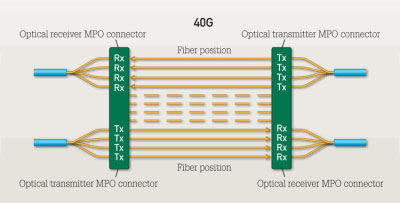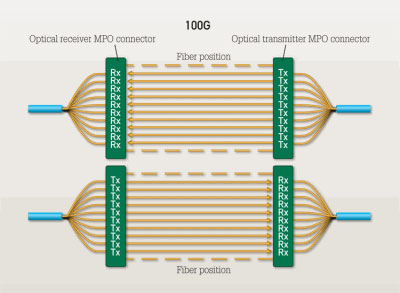With the continued requirement for expansion and scalability in the data center, cabling infrastructures must provide reliability, manageability and flexibility. Deployment of an optical connectivity solution allows for an infrastructure that meets these requirements for current and future data rates. A key factor when choosing the type of optical connectivity is scalability. Scalability refers to not only the physical expansion of the data center with respect to additional servers, switches or storage devices, but also to the scalability of the infrastructure to support a migration path for increasing data rates. As technology evolves and standards are completed to define data rates such as 40- and 100-Gbit Ethernet, 32-Gbit and higher-speed Fibre Channel, and 40-Gbit and higher-speed InfiniBand, the cabling infrastructures installed today must provide scalability to accommodate the need for more bandwidth in support of future applications.

One- and 10-Gbit/sec data rates are not adequate to meet the future needs of high-bandwidth applications. The requirement for higher data rates is being driven by many factors. Switching and routing, virtualization, convergence and high-performance computing environments are examples of where these higher network speeds will be required within the data center environment. Additionally, Internet exchanges and service provider peering points and high-bandwidth applications, such as video-on-demand, will drive the need for a migration from 10- to 40- and 100-Gbit interfaces.
The Institute of Electrical and Electronics Engineers (IEEE; www.ieee.org) 802.3ba 40G/100G Ethernet standard was ratified in June 2010. The standard provides detailed guidance for 40/100G transmission with multimode and singlemode fibers. The standard does not have guidance for Category-based unshielded twisted-pair or shielded twisted-pair copper cable.
OM3 and OM4 are the only multimode fibers included in the standard. Multimode fiber uses parallel-optics transmission instead of serial transmission due to the 850-nm vertical-cavity surface-emitting laser (VCSEL) modulation limits at the time the guidance was developed. Singlemode fiber guidance uses duplex fiber wavelength division multiplexing (WDM) serial transmission. 40/100G multimode fiber physical media dependent (PMD) variants continue to offer a significant value proposition compared to singlemode fiber PMDs for short-length interconnects in the data center.
Parallel-optics transmission, compared to traditional serial transmission, uses a parallel optical interface where data is simultaneously transmitted and received over multiple fibers. The 40G and 100G Ethernet interfaces are 4x10G channels on four fibers per direction, and 10x10G channels on 10 fibers per direction, respectively.
The table on page 19 provides the OM3- and OM4-specified distances for Ethernet. Each distance assumes 1.5 dB total connector loss with the exception of OM4 40G/100G, which assumes 1.0 dB total connector loss. OM3 and OM4 are fully capable to support legacy and emerging data rates, as a 15- to 20-year service life is expected for the physical layer.

When evaluating the performance needed for the OM3 and OM4 cabling infrastructure to meet the requirements for 40G and 100G Ethernet channel insertion loss transmission, three criteria should be considered: 1) bandwidth, 2) total connector insertion loss, and 3) skew. Each of these factors can impact the cabling infrastructure’s ability to meet the standard’s specified transmission distances.
Bandwidth. OM3 and OM4 fibers were selected as the only multimode fiber for 40G/100G consideration. The fibers are optimized for 850-nm transmission and have a minimum 2000 MHz.km and 4700 MHz.km effective modal bandwidth (EMB), respectively. Two EMB measurement techniques are used today for the bandwidth measurement. The minimum effective modal bandwidth calculated (EMBc) method, in our opinion, offers a more reliable and precise measurement compared to the differential mode delay (DMD) mask technique. With minEMBc, a true scalable bandwidth value is calculated that can reliably predict performance for different data rates and link lengths. With a connectivity solution using OM3 and OM4 fibers that have been measured using the minEMBc technique, the optical infrastructure deployed in the data center will meet the performance criteria set forth by IEEE for bandwidth.


Insertion loss. Insertion loss is a critical performance parameter in current data center cabling deployments. Total connector loss within a system channel impacts the ability of a system to operate over the maximum supportable distance for a given data rate. The 40G and 100G Ethernet standard specifies the OM3 fiber 100-meter distance maximum channel loss to be 1.9 dB, which includes a 1.5-dB total connector loss. The OM4 fiber 150-meter distance maximum channel loss is 1.5 dB, which includes a 1.0-dB total connector loss budget. The insertion loss specifications of the MPO connectivity components should be evaluated when designing data center cabling infrastructures. With low-loss MPO connectivity components, maximum flexibility can be achieved with the ability to introduce multiple connector matings into the connectivity link such that structured cabling architectures can be supported.
Skew. The IEEE 802.3ba standard includes an optical media skew of 79 ns. Optical skew–the difference in time of flight between light signals traveling on different fibers–is an essential consideration for parallel-optics transmission. With excessive skew, or delay, across the various channels, transmission errors can occur. Skew testing on MPO connectivity solutions has demonstrated compliance to a strict 0.75-ns skew requirement as defined in the InfiniBand standard. Deployment of a connectivity solution with strict skew performance ensures compatibility of the cabling infrastructure across a variety of applications. When evaluating optical cabling infrastructure solutions for 40G/100G applications, selecting one that meets the 0.75-ns skew requirement ensures performance not only for 40G/100G, but also for InfiniBand and future Fibre Channel data rates. Additionally, low-skew connectivity solutions validate the quality and consistency of cable designs and terminations to provide long-term reliable operation.
Source from: BY DAVID KOZISCHEK AND DOUG COLEMAN, CORNING CABLE SYSTEMS